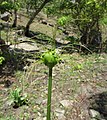East Indian arrowroot
| East Indian arrowroot | ||||||||||||
|---|---|---|---|---|---|---|---|---|---|---|---|---|

Tacca pinnatifida , illustration |
||||||||||||
| Systematics | ||||||||||||
|
||||||||||||
| Scientific name | ||||||||||||
| Tacca leontopetaloides | ||||||||||||
| ( L. ) Kuntze |
East Indian arrowroot ( Tacca leontopetaloides , syn .: Tacca pinnatifida J.R.Forst. & G.Forst. ), Also called pia , loki or green bat lily, is a useful plant from the Dioscoreaceae family .
description
The herbaceous perennial plant has very few and very long and stalked leaves . The entire, bare leaves are cut into three parts, hand-shaped, and the pinnate lobes are lobed to cut. They emerge from the tuber with a 60–90 cm long, ribbed and hollow petiole .
It usually forms one or two large, upright, green inflorescences from the tubers on an approximately 1.5 m long, thick, ribbed, hollow inflorescence stem. The approximately 20 to 30 long-stemmed flowers stand in a cone with a large, greenish involucre with leaf-like bracts , interrupted by several green to violet, long about 12-20 cm, thread-like bracts , barbels. The hermaphroditic flowers are threefold with a simple flower envelope . The 6 tepals are green to yellow, the tips sometimes purple, and they are in two circles. The 6 anthers are attached to the tepals in a hood-like, petaloid structure (stamens). The ovary is underneath in an angular flower cup and the striking, wide stigma on a short stylus is three-lobed with two-part, heart-shaped lobes. There is a discus .
Ribbed, smooth and round to ellipsoidal, many-seeded, about 2.5-3.5 centimeters long, yellow-brownish berries with perigone remnants at the tip are formed. The ribbed, egg-shaped and yellow-brown seeds, with a soft seed coat , are 5-8 millimeters in size and have a thin aril .
From the prior leaves of the axillary buds, tube-like bulges develop, which elongate like runners and then swell to potato-like, yellowish tubers with a few "eyes". Morphologically, the tubers emerge from axillary buds. These usually have a weight of around 100 to 350 g or a little more, and a size of 10-15 centimeters.
distribution
The East Indian arrowroot is originally found from the tropics of Africa, Asia and Australia to the islands in the Pacific.
ingredients
The tubers contain around 25-27.5% starch ( dry matter ) and are traded as Tahiti, Fidji or East Indian Arrowroot.
Cultivation and use
In addition to the islands on which it originally occurs, this plant species is also cultivated to a small extent in China , Indochina , India and Cameroon . It has always been an important food in the Fiji Islands and has been spread from there to Polynesia and Malaysia .
preparation
The sprout tubers are bitter and must be watered before processing. The starch makes a good "bread flour" and is also cooked or used as laundry starch.
photos
literature
- TK Lim: Edible Medicinal and Non-Medicinal Plants. Volume 10: Modified Stems, Roots, Bulbs , Springer, 2016, ISBN 978-94-017-7275-4 , pp. 301-307.
- W. Franke : Crop science. 3rd edition, Thieme, 1985, ISBN 3-13-530403-5 .
- KV Peter, MS Palaniswami: Tuber & Root Crops. NIPA, 2008, ISBN 81-89422-53-7 , pp. 68 f.
- Klaus Kubitzki : The Families and Genera of Vascular Plants. Vol. III: Flowering Plants Monocotyledons , Springer, 1998, ISBN 978-3-642-08377-8 (Reprint), p. 425 ff.
- Tacca leontopetaloides at PROTA.
Individual evidence
- ^ Rafaël Govaerts (ed.): Tacca - World Checklist of Selected Plant Families of the Royal Botanic Gardens, Kew. Last accessed on June 24, 2018.
Web links
- Tacca leontopetaloides at Useful Tropical Plants.
- Tacca leontopetaloides . In: S. Dressler, M. Schmidt, G. Zizka (Eds.): African plants - A Photo Guide. Senckenberg, Frankfurt / Main 2014.
- Taccaceae at DELTA (with illustrations).
- Tacca leontopetaloides from Australian Tropical Rainforest Plants, accessed October 11, 2019.
- Tacca leontopetaloides inthe IUCN 2013 Red List of Threatened Species . Posted by: Contu, S., 2009. Retrieved April 26, 2014.



